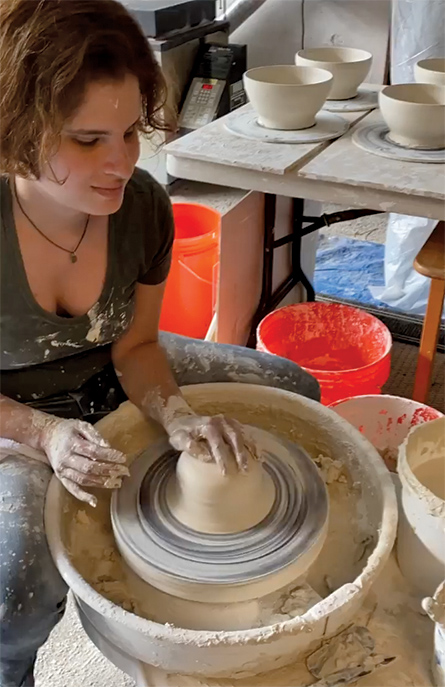Tasha Chemel
Tasha Chemel is sitting at her potter’s wheel in the middle of a two-car garage on a winding, residential road in Newton, MA. Late-summer sunlight shines on her back.

Would-be parking spaces hold a kiln and work benches stacked with clay, tools and works-in-progress: grey vessels awaiting trimming; a row of unattached mug handles that look like disembodied ears. Shelves that might otherwise hold garden tools or sports gear are lined with deep bowls and generous mugs glazed in “signature white.”
Chemel’s work-from-home arrangement came about when her usual workspace at the Harvard Ceramics Studio in Allston, MA temporarily closed in 2020. The ad-hoc studio has some advantages. “Here I can just come out and throw on my own,” Chemel says. Chemel is blind and has limitations with spatial navigation, which she thinks may be an undiagnosed spatial learning disability. When she works at Harvard, she needs an assistant to help her navigate the space and set up. In the garage attached to her family home, she can head out when the mood strikes her, get a cup of rooibos tea, put on a podcast and knead or throw clay.
Chemel still works with an assistant for other steps in her process. This afternoon, she and Jared Hostutler are masked, sitting across from each other at arm’s length from the wheel. They discuss the next steps for a mug–where to start trimming and how much. Chemel evaluates the weight and shape of the vessel with her hands, and asks Hostutler for input. This consultation is a “prime moment of challenging the assumption that ceramics is a purely tactile medium,” Chemel says. “It’s visual and tactile. Both touch and sight are valid sources of information and I like to have access to both of them.” It becomes a kind of linguistic medium, too. She and her assistants use a combination of terms of art and an unofficial lingo that evolves through their partnership. “Sometimes words don’t work,” she says, “and at that point it’s helpful if someone will just guide my hand.”
Having all of the “channels” open is important to Chemel. A self-proclaimed perfectionist, Chemel’s designs reflect her commitment to precision: milk bottle vases; broad, deep bowls; mugs that nest perfectly in two hands. All are glazed in a glossy white that emphasizes shape and balance. “I vibe with the pristine,” says Chemel.

There’s whimsy and joy in her work, too. Some of her popular Braille mugs include custom, “NSFW” punchlines most people can’t read.
Looking at the tidy rows of finished pieces lining the walls and shelves in her studio, an inexperienced observer might assume she has mastered the process, that production is now a simple matter of applying the time and energy. The action at the wheel tells another story. Chemel and Hostutler discuss and deliberate, down to a pinkie-finger-width or smaller, where the trimming should begin, how much, or whether anything is fractionally off-center or wobbly.
Chemel is open and thoughtful about the challenges and frustrations that are part of her evolution as an artist. Her mother, also an artist, started Chemel in ceramics as a grade-schooler. Chemel describes an undergraduate course she took at RISD as “a humbling experience” that revealed to her how much more she had to and wanted to learn about pottery, and also helped her discover the methods and approaches that work best for her. Her decision to start selling her work in 2013 was another turning point at which she embraced the pursuit of precision and uniformity.
“I’m a person who has always wanted to explore creative realms,” says Chemel. She’s a writer, too, and in her writing as well as in her ceramics work, she has some “sadness and yearning” when it comes to phenomena that she doesn’t experience the way other people do, such as color, or rendering a three-dimensional image on a two-dimensional plane. “I have that same curiosity,” she says, “but I don’t always have a way to honor that in myself.” When it comes to choices like the glaze for her work, she consults with her mother and with her assistants. “I don’t want to make a choice [like color] based on an abstraction.”
Chemel is excited about science that could allow her to access new sensory input, such as recent occasions when, with the aid of medical marijuana, she was able to experience eye contact and light reflecting off the water for the first time. “If I had all of the information,” she wonders, “would I make the same choices?”
Many people are asking themselves these questions as the pandemic stretches on and everyday life is full of predicaments and losses that few could have anticipated. Another of Chemel’s assistants, Adria Katz, noted that pandemic shutdowns were particularly challenging for potters. Maintaining a fully equipped ceramics studio is so difficult, people almost always work in a shared space. She and Chemel “both developed a lot of community through pottery. That was a hard thing to lose.”
Chemel’s garage, where buckets stand in for proper sinks and buzzing flies threaten newly smoothed vases, is a testament to technical ingenuity. It also represents a reclamation of her connection with other potters and their shared connection with the clay.
In September 2020, Chemel posted a photo of two bowls with holes in the bottoms on her Instagram feed. The caption resonates on the cluttered walls of her studio: “Success and symmetry reveal a certain kind of beauty that we wouldn’t know without a bunch of practice and failure, an occasional misfire. And here we have two lost bowls to the kiln. Here’s to all the loss and growth that goes into that polished end result.”
